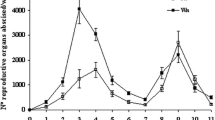Abstract
The effects of external treatments with gibberellin, brassinosteroid and auxin on sexual determination and flower development in pomegranate (Punica granatum L. cv. Çekirdeksiz) were investigated. Eigth treatments with three growth regulators, viz., epibrassinolide at 0.01 and 0.1 ppm, homobrassinolide at 0.01 and 0.1 ppm, GA3 at 10 and 25 ppm, NAA at 5 and 15 ppm and control (water spray) were sprayed at the time of initiation of new sprouts. Effects of the plant growth regulators on the percent of the flowers types were not clear. Plants produced considerably more male flowers. Although no statistical importance was detected, it was clear that all growth regulators decreased bisexual flowers and increased male flowers. There were no significant effects of growth regulators on the formation of bisexual flowers at different positions in the plants. The percentage of single bisexual flower was significantly higher than terminal or lateral bisexual flower in a cluster in the control plants. Effects of the plant growth regulators on the size of the parts of the bisexual pistils were, however, found important. The smallest ovaries were obtained from 0.1 ppm HBr, base to sepal notch was the only characteristic which was not influenced by the treatments and stayed between 15 and 18 mm. Total pistil length of the bisexual flowers was greatest with EBr applications and the shortest with the HBr treatments (about 27.5 mm). Length of the style and stigma was mostly shorter, but 0.1 ppm EBr boosted it up comparably more than the rest of the applications including the control. Stigma, on the other hand, was widest in the control flowers, closely followed by all except 0.1 ppm EBr application.


Similar content being viewed by others
References
Abubakar AR, Ashraf N, Ashraf M (2012) Effect of plant biostimulants on flowering, fruit drop, yield, and return bloom of pomegranate cv. Kandhari Kabuli. Asian J Hortic 7(2):473–477
Ahire GZ, Desai UT, Chaudhari SW, Masalkar SD (1993) Crop regulation in pomegranate: 1. Effect of growth regulators on flower induction, sex and flower drop. Ann Arid Zone 32(2):97–98
Anawal VV, Narayanaswamy P, Kumar HS (2015) Effects of plant growth regulators on induction of flowering in pomegranate (Punica granatum L.) cv. Bhagwa. Int J Sci Res 4(12):7–9
Arteca RN, Tsai DS, Schlagnhaufer C, Mandava NB (1983) The effect of brassinosteroid on auxin-induced ethylene production by etiolated mung bean segments. Physiol Plant 59:539–544
Chaudhari SM, Desai UT (1993) Effects of plant growth regulators on flower sex in pomegranate (Punica granatum L.). Indian J Agric Sci 63:34–35
Engin H, Gökbayrak Z (2017) Flower biology of some Turkish pomegranates. Vocarstwo- Journal of Pomology 51(197–198): 47–52.
Freeman DC, Harper KT, Charnov EL (1980) Sex change in plants: old and new observations and new hypotheses. Oecologia 47:222–232
Goswami JD, Patel NM, Bhadauria HS, Wankhade VR (2013) Effect of plant growth regulators on quality traits of pomegranate cv. Sindur. Asian J Hortic 8(1):361–363
Khryanin VN (2002) Role of phytohormones in sex differentiation in plants. Russ J Plant Physiol 49:545–551
Manzano S, Martinez C, Megias Z, Gomez P, Garrido D (2011) The role of ethylene and brassinosteroids in the control of sex expression and flower development in Cucurbita pepo. Plant Growth Regul 65:213–221
Mars M (2000) Pomegranate plant material: genetic resources and breeding, a review. Options Mediterraneennes Serie A 42, pp 55–62
Papadopoulou E, Little HA, Hammar SA, Grumet R (2005) Effect of modified endogenous ethylene production on sex expression bisexual flower development and fruit production in melon (Cucumis melo L.). Sex Plant Reprod 18:131–142
Vardhini BV, Rao SSR (2002) Acceleration of ripening of tomato pericarp discs by brassinosteroids. Phytochemistry 61:843–847
Wetzstein HY, Ravid N, Wilkins E, Martinelli AP (2011) A morphological and histological characterization of bisexual and male flower types in pomegranate. J Am Soc Hortic Sci 136(2):83–92
Woeste KE, Ye C, Kieber JJ (1999) Two Arabidopsis mutants that overproduce ethylene are affected in the posttranscriptional regulation of 1‑aminocyclopropane-1-carboxylic acid synthase. Plant Physiol 119:521–529
Yılmaz C (2007) Nar. Hasad Yayıncılık, İstanbul, p 190 (in Turkish)
Author information
Authors and Affiliations
Corresponding author
Ethics declarations
Conflict of interest
H. Engin and Z. Gökbayrak declare that they have no competing interests.
Rights and permissions
About this article
Cite this article
Engin, H., Gökbayrak, Z. Effects of Plant Growth Regulators on Sex Expression and Flower Development in Pomegranates. Erwerbs-Obstbau 61, 23–27 (2019). https://doi.org/10.1007/s10341-018-0384-8
Received:
Accepted:
Published:
Issue Date:
DOI: https://doi.org/10.1007/s10341-018-0384-8




